The Potential Role of Zinc and Silicon in Improving Grain Yield and Lodging Resistance of Rice (Oryza sativa L.)
Abstract
:1. Introduction
2. Materials and Methods
2.1. Experimental Sites, Treatments, and Design
2.2. Data Collection
2.2.1. Determination of Yield Parameters
2.2.2. Determination of Stem and Root Lodging Parameters
2.2.3. Determination of the Safety Factor as an Indicator of Lodging Resistance
2.2.4. Data Analysis
3. Results
3.1. Grain Yield and Related Parameters
3.2. Lodging-Associated Traits
3.3. PERMANOVA, Pearson’s Correlations, and PCA Analyses
4. Discussion
4.1. Grain Yield and the Associated Traits under Various Levels of Zn and Si
4.2. Crop Lodging as Influenced by the Application of Zn and Si
4.3. A Comparison between Stem Lodging and Root Lodging
5. Conclusions
Supplementary Materials
Author Contributions
Funding
Data Availability Statement
Conflicts of Interest
References
- Mohidem, N.A.; Hashim, N.; Shamsudin, R.; Che Man, H. Rice for food security: Revisiting its production, diversity, rice milling process and nutrient content. Agriculture 2022, 12, 741. [Google Scholar] [CrossRef]
- Rizzo, G.; Monzon, J.P.; Tenorio, F.A.; Howard, R.; Cassman, K.G.; Grassini, P. Climate and agronomy, not genetics, underpin recent maize yield gains in favorable environments. Proc. Natl. Acad. Sci. USA 2022, 119, e2113629119. [Google Scholar] [CrossRef] [PubMed]
- Tilman, D.; Balzer, C.; Hill, J.; Befort, B.L. Global food demand and the sustainable intensification of agriculture. Proc. Natl. Acad. Sci. USA 2011, 108, 20260–20264. [Google Scholar] [CrossRef] [PubMed]
- Ray, D.; Ramankutty, N.; Mueller, N.; West, P.C.; Foley, J.A. Recent patterns of crop yield growth and stagnation. Nat. Commun. 2012, 3, 1293. [Google Scholar] [CrossRef] [PubMed]
- Cakmak, I. Plant nutrition research: Priorities to meet human needs for food in sustainable ways. Plant Soil 2002, 247, 3–24. [Google Scholar] [CrossRef]
- Zhang, Y.; Lu, X.A. Comprehensive evaluation of food security in China and its obstacle factors. Int. J. Environ. Res. Public Health 2022, 20, 451. [Google Scholar] [CrossRef] [PubMed]
- Cui, K.; Shoemaker, S.P. A look at food security in China. npj Sci. Food 2018, 2, 4. [Google Scholar] [CrossRef] [PubMed]
- Sia, S.F.; Simbo, D.; John, K.N.; Elena, P.; Meisam, Z. The efficacy of micronutrient fertilizers on the yield formulation and quality of wheat grains. Agronomy 2023, 13, 566. [Google Scholar] [CrossRef]
- Wang, S.; Xu, L.; Hao, M. Impacts of long-term micronutrient fertilizer application on soil properties and micronutrient availability. Int. J. Environ. Res. Public Health 2022, 19, 16358. [Google Scholar] [CrossRef]
- Janaki, D.; Kumar, S. Effect of micronutrient mixture on yield and quality of guava cv lucknow 49 in sodic soil. Int. J. Plant Soil Sci. 2023, 35, 1876–1881. [Google Scholar] [CrossRef]
- Arif, N.; Yadav, V.; Singh, S.; Singh, S.; Ahmad, P.; Mishra, R.K.; Sharma, S.; Tripathi, D.K.; Dubey, N.K.; Chauhan, D.K. Influence of high and low levels of plant-beneficial heavy metal ions on plant growth and development. Front. Environ. Sci. 2016, 4, 69. [Google Scholar] [CrossRef]
- Saleem, M.H.; Usman, K.; Rizwan, M.; Jabri, H.A.; Alsafran, M. Functions and strategies for enhancing zinc availability in plants for sustainable agriculture. Front. Plant Sci. 2022, 7, 1033092. [Google Scholar] [CrossRef] [PubMed]
- Kheyri, N.; Norouzi, H.A.; Mobasser, H.R.; Torabi, B. Effects of Silicon and Zinc nanoparticles on growth, yield and biochemical characteristics of rice. Agron. J. 2019, 111, 3084–3090. [Google Scholar] [CrossRef]
- Hanikenne, M.; Esteves, S.M.; Fanara, S.; Rouached, H. Coordinated homeostasis of essential mineral nutrients: A focus on iron. J. Exp. Bot. 2021, 72, 2136–2153. [Google Scholar] [CrossRef] [PubMed]
- Wissuwa, M.; Ismail, A.M.; Yanagihara, S. Effects of zinc deficiency on rice growth and genetic factors contributing to tolerance. Plant Physiol. 2006, 142, 731–741. [Google Scholar] [CrossRef] [PubMed]
- Huang, S.; Yamaji, N.; Ma, J.F. Zinc transport in rice: How to balance optimal plant requirements and human nutrition. J. Exp. Bot. 2022, 73, 1800–1808. [Google Scholar] [CrossRef] [PubMed]
- Rahman, M.; Jahangir, M.M.R.; Kibria, M.G.; Hossain, M.; Hosenuzzaman, M.; Solaiman, Z.M.; Abedin, M.A. Determination of critical limit of zinc for rice (Oryza sativa L.) and potato (Solanum tuberosum L.) cultivation in floodplain soils of Bangladesh. Sustainability 2022, 14, 167. [Google Scholar] [CrossRef]
- Lilay, G.H.; Persson, D.P.; Castro, P.H. Arabidopsis bZIP19 and bZIP23 act as zinc sensors to control plant zinc status. Nat. Plants 2021, 7, 137–143. [Google Scholar] [CrossRef]
- Walker, C.L.; Ezzati, M.; Black, R.E. Global and regional child mortality and burden of disease attributable to zinc deficiency. Eur. J. Clin. Nutr. 2009, 63, 591–597. [Google Scholar] [CrossRef]
- Rehman, H.; Aziz, T.; Farooq, M.; Wakeel, A.; Rengel, Z. Zinc nutrition in rice production systems: A review. Plant Soil 2012, 361, 203–226. [Google Scholar] [CrossRef]
- Coskun, D.; Britto, D.T.; Huynh, W.Q.; Kronzucker, H.J. The role of silicon in higher plants under salinity and drought stress. Front. Plant Sci. 2016, 7, 1072. [Google Scholar] [CrossRef] [PubMed]
- Coskun, D.; Deshmukh, R.; Sonah, H.; Menzies, J.G.; Reynolds, O.; Ma, J.F.; Kronzucker, H.J.; Bélanger, R.R. In defence of the selective transport and role of silicon in plants. New Phytol. 2019, 223, 514–516. [Google Scholar] [CrossRef] [PubMed]
- Bockhaven, J.V.; Vleesschauwer, D.D.; Höfte, M. Towards establishing broad-spectrum disease resistance in plants: Silicon leads the way. J. Exp. Bot. 2013, 64, 1281–1293. [Google Scholar] [CrossRef] [PubMed]
- Savant, N.K.; Snyder, G.H.; Datnoff, L.E. Silicon management and sustainable rice production. Adv. Agron. 1996, 58, 151–199. [Google Scholar] [CrossRef]
- Shah, L.; Yahya, M.; Shah, S.M.A.; Nadeem, M.; Ali, A.; Wang, J.; Riaz, M.W.; Rehman, S.; Wu, W. Improving lodging resistance: Using wheat and rice as classical examples. Int. J. Mol. Sci. 2019, 20, 4211. [Google Scholar] [CrossRef] [PubMed]
- Wu, W.; Shah, F.; Ma, B.L. Understanding of crop lodging and agronomic strategies to improve the resilience of rapeseed production to climate change. Crop Environ. 2022, 1, 133–144. [Google Scholar] [CrossRef]
- Wu, W.; Ma, B.L. Understanding the trade–off between lodging resistance and seed yield, and developing some non–destructive methods for predicting crop lodging risk in canola production. Field Crops Res. 2022, 288, 108691. [Google Scholar] [CrossRef]
- Wu, W.; Ma, B.L.; Fan, J.J.; Sun, M.; Yi, Y.; Guo, W.S.; Voldeng, H.D. Management of nitrogen fertilization to balance reducing lodging risk and increasing yield and protein content in spring wheat. Field Crops Res. 2019, 241, 107584. [Google Scholar] [CrossRef]
- Li, Z.J.; Liu, F.C.; Wu, W. Optimising nitrogen management strategies to minimise lodging risk while sustaining high seed yield in rapeseed. Eur. J. Agron. 2023, 142, 126671. [Google Scholar] [CrossRef]
- Liao, P.; Bell, S.M.; Chen, L.; Huang, S.; Wang, H.Y.; Miao, J.H.; Qi, Y.M.; Sun, Y.N.; Liao, B.; Zeng, Y.J.; et al. Improving rice grain yield and reducing lodging risk simultaneously: A meta-analysis. Eur. J. Agron. 2023, 143, 126709. [Google Scholar] [CrossRef]
- Wu, W.; Liao, Y.C.; Shah, F.; Nie, L.X.; Peng, S.B.; Cui, K.H.; Huang, J.L. Plant growth suppression due to sheath blight and the associated yield reduction under double rice-cropping system in central China. Field Crops Res. 2013, 144, 268–280. [Google Scholar] [CrossRef]
- Wu, W.; Ma, B.L. Assessment of canola crop lodging under elevated temperatures for adaptation to climate change. Agric. For. Meteorol. 2018, 248, 329–338. [Google Scholar] [CrossRef]
- Wu, W.; Shah, F.; Duncan, R.W.; Ma, B.L. Grain yield, root growth habit and lodging of eight oilseed rape genotypes in response to a short period of heat stress during flowering. Agric. For. Meteorol. 2020, 287, 107954. [Google Scholar] [CrossRef]
- Tuiwong, P.; Lordkaew, S.; Veeradittakit, J.; Jamjod, S.; Prom-u-thai, C. Efficacy of nitrogen and zinc application at different growth stages on yield, grain zinc, and nitrogen concentration in rice. Agronomy 2022, 12, 2093. [Google Scholar] [CrossRef]
- Tian, Z.; Li, J.; He, X.; Jia, X.; Yang, F.; Wang, Z. Grain yield, dry weight and phosphorus accumulation and translocation in two rice (Oryza sativa L.) varieties as affected by salt-alkali and phosphorus. Sustainability 2017, 9, 1461. [Google Scholar] [CrossRef]
- Samreen, T.; Shah, H.H.U.; Ullah, S.; Javid, M. Zinc effect on growth rate, chlorophyll, protein and mineral contents of hydroponically grown mungbeans plant (Vigna radiata). Arab. J. Chem. 2017, 10, 1802–1807. [Google Scholar] [CrossRef]
- Hong, W.Y.; Chen, Y.J.; Huang, S.H.; Li, Y.Z.; Wang, Z.M.; Tang, X.R.; Pan, S.G.; Tian, H.; Mo, Z.M. Optimization of nitrogen–silicon (N-Si) fertilization for grain yield and lodging resistance of early-season indica fragrant rice under different planting methods. Eur. J. Agron. 2022, 136, 126508. [Google Scholar] [CrossRef]
- Dorairaj, D.; Ismail, M.R.; Sinniah, U.R.; Kar Ban, T. Influence of silicon on growth, yield, and lodging resistance of MR219, a lowland rice of Malaysia. J. Plant. Nutr. 2017, 40, 1111–1124. [Google Scholar] [CrossRef]
- Liu, X.W.; Huang, Z.L.; Li, Y.Z.; Xie, W.J.; Li, W.; Tang, X.R.; Ashraf, U.; Kong, L.L.; Wu, L.M.; Wang, S.L.; et al. Selenium-silicon (Se-Si) induced modulations in physio-biochemical responses, grain yield, quality, aroma formation and lodging in fragrant rice. Ecotoxicol. Environ. Saf. 2020, 196, 110525. [Google Scholar] [CrossRef]
- Wu, Q.; Liu, C.; Wang, Z.; Gao, T.; Liu, Y.; Xia, Y.; Yin, R.; Qi, M. Zinc regulation of iron uptake and translocation in rice (Oryza sativa L.): Implication from stable iron isotopes and transporter genes. Environ. Pollut. 2022, 297, 118818. [Google Scholar] [CrossRef]
- Hirano, K.; Ordonio, R.L.; Matsuoka, M. Engineering the lodging resistance mechanism of post-Green Revolution rice to meet future demands. Proc. Jpn. Acad. Ser. B Phys. Biol. Sci. 2017, 93, 220–233. [Google Scholar] [CrossRef] [PubMed]

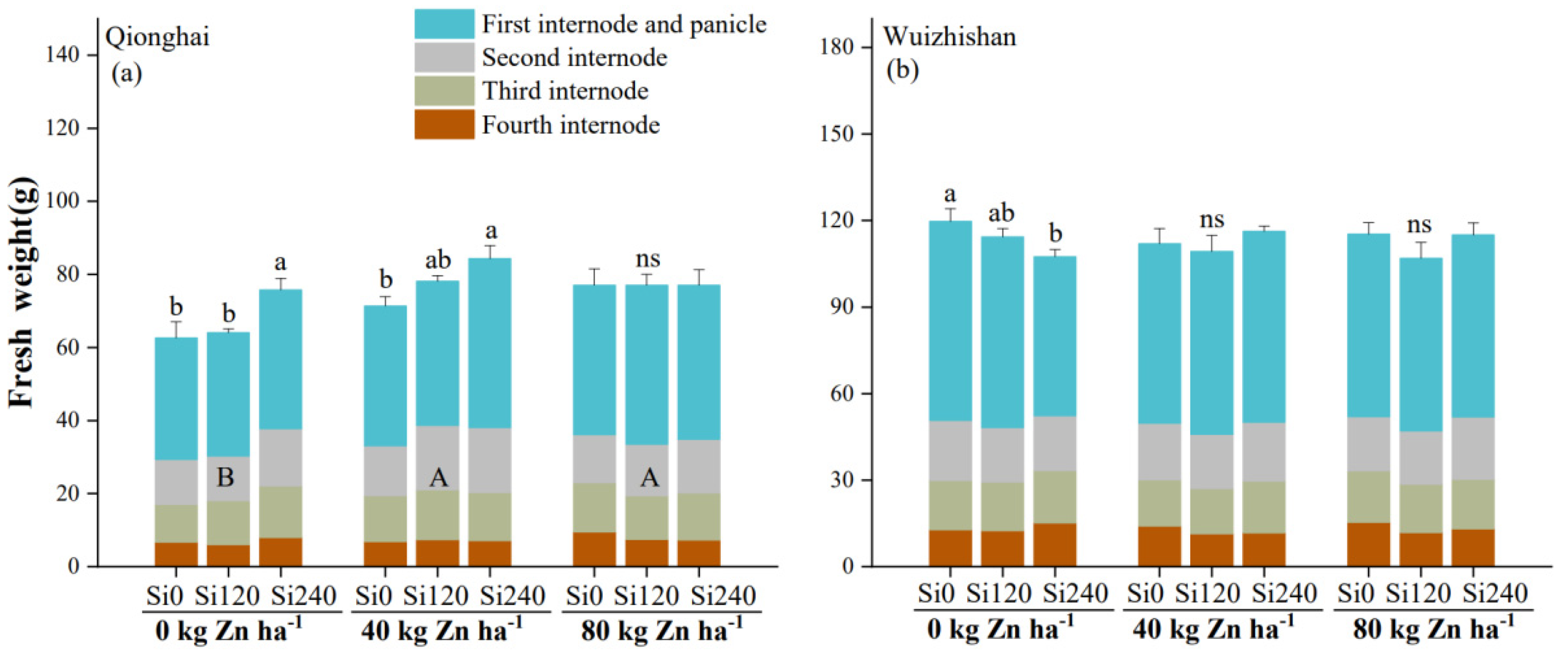
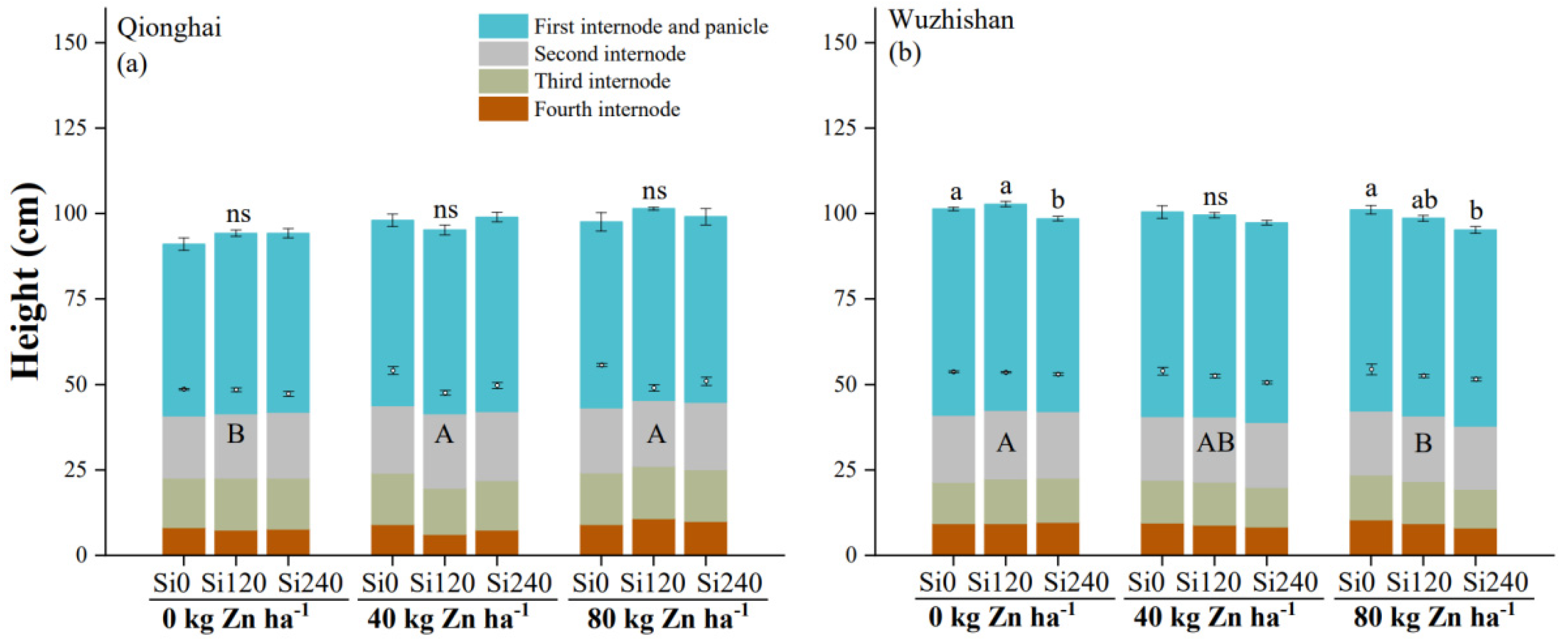
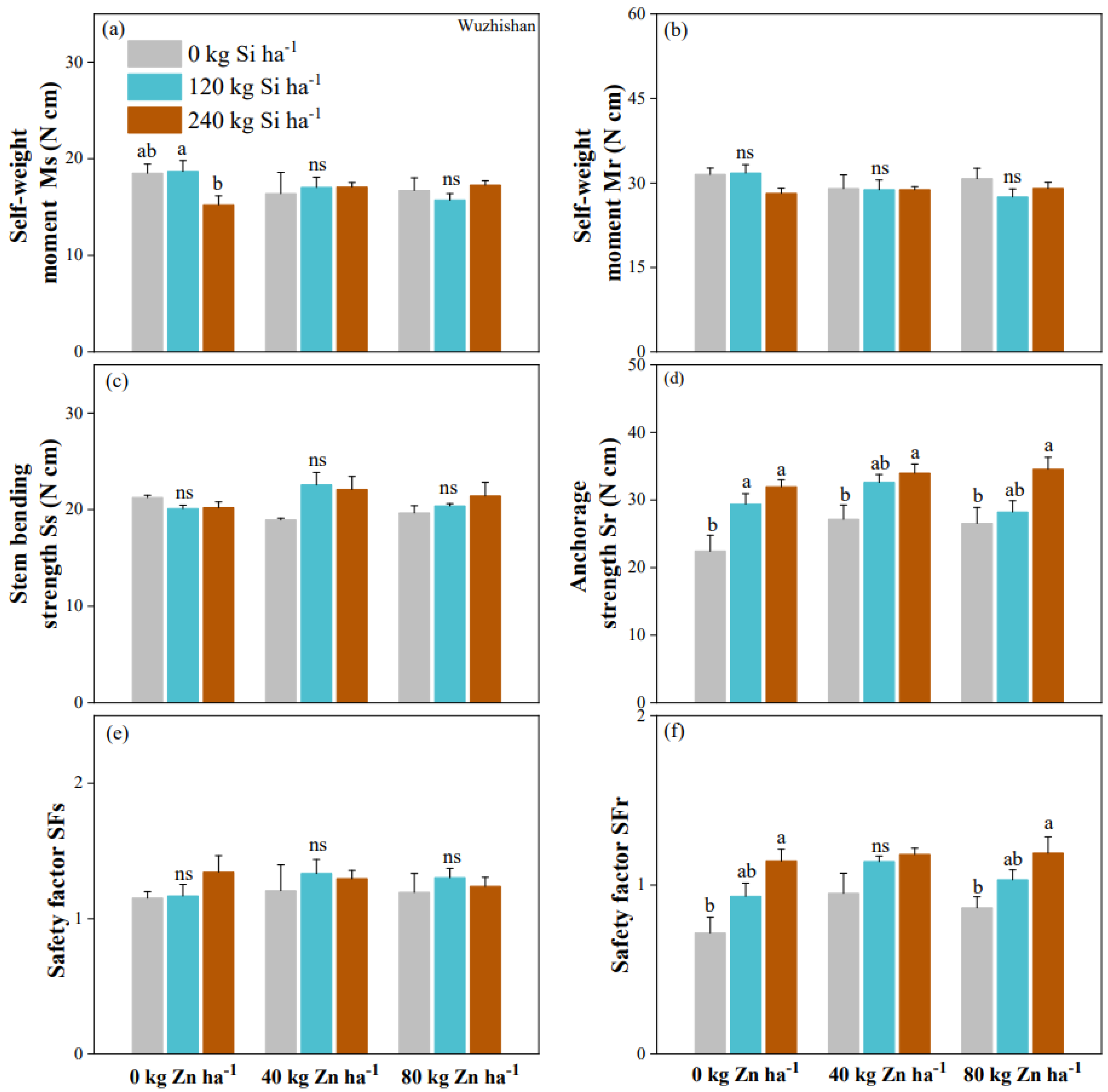
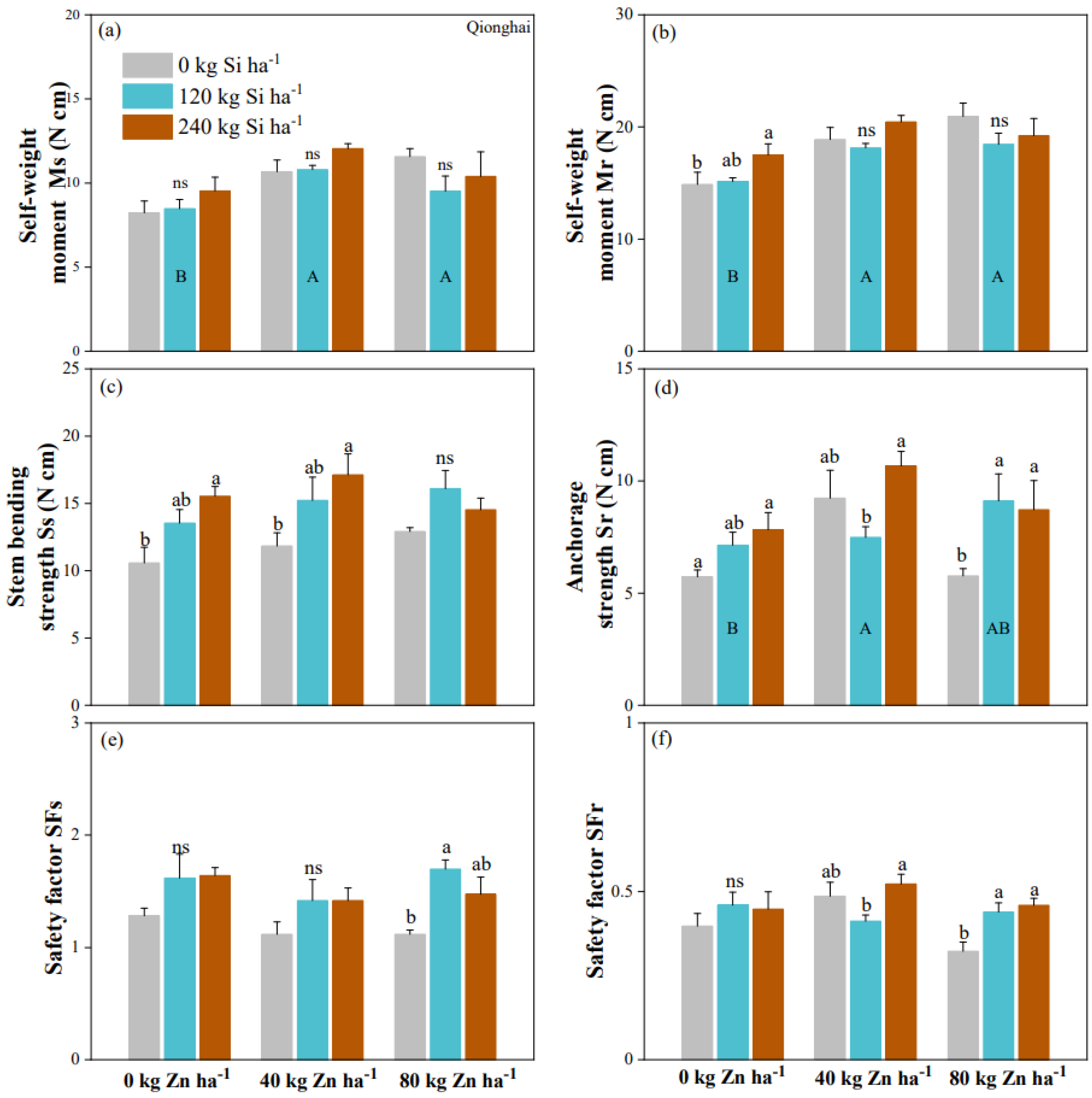
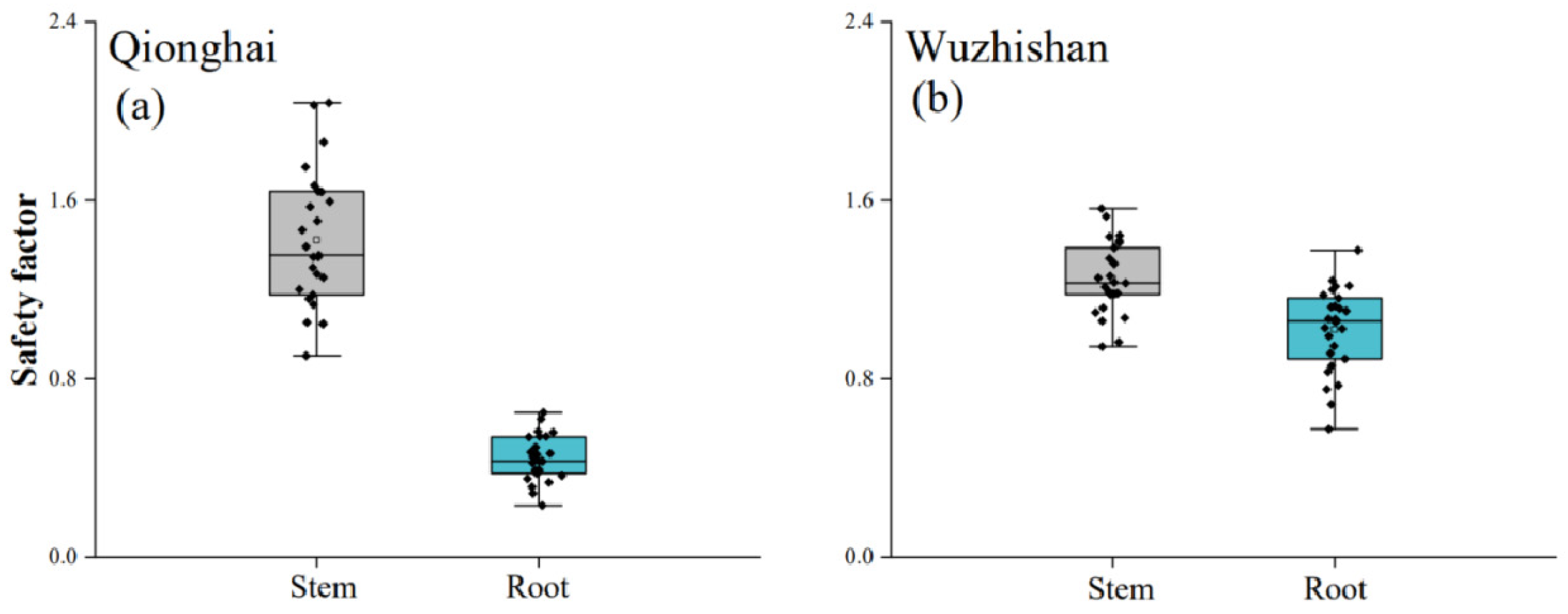
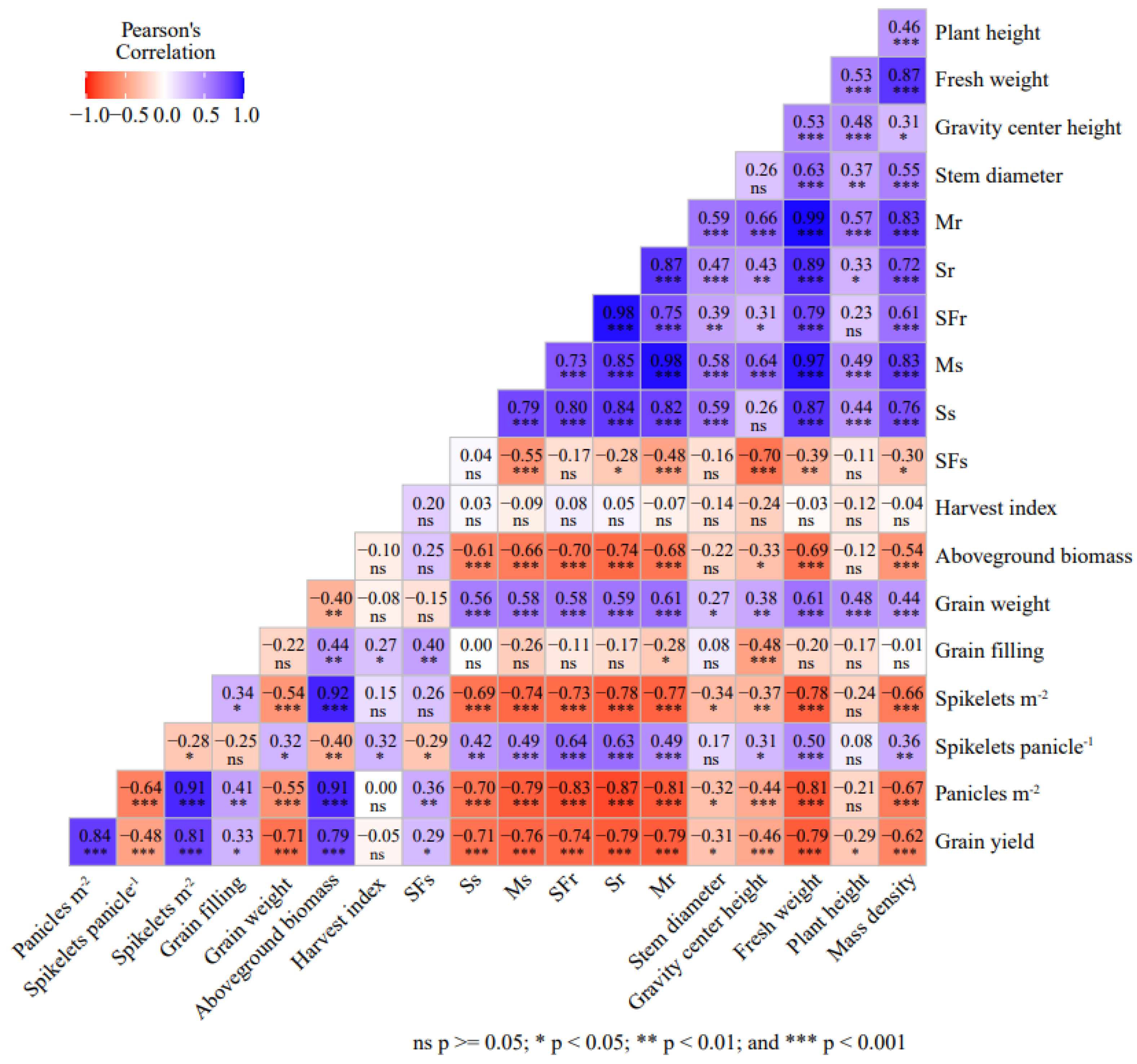
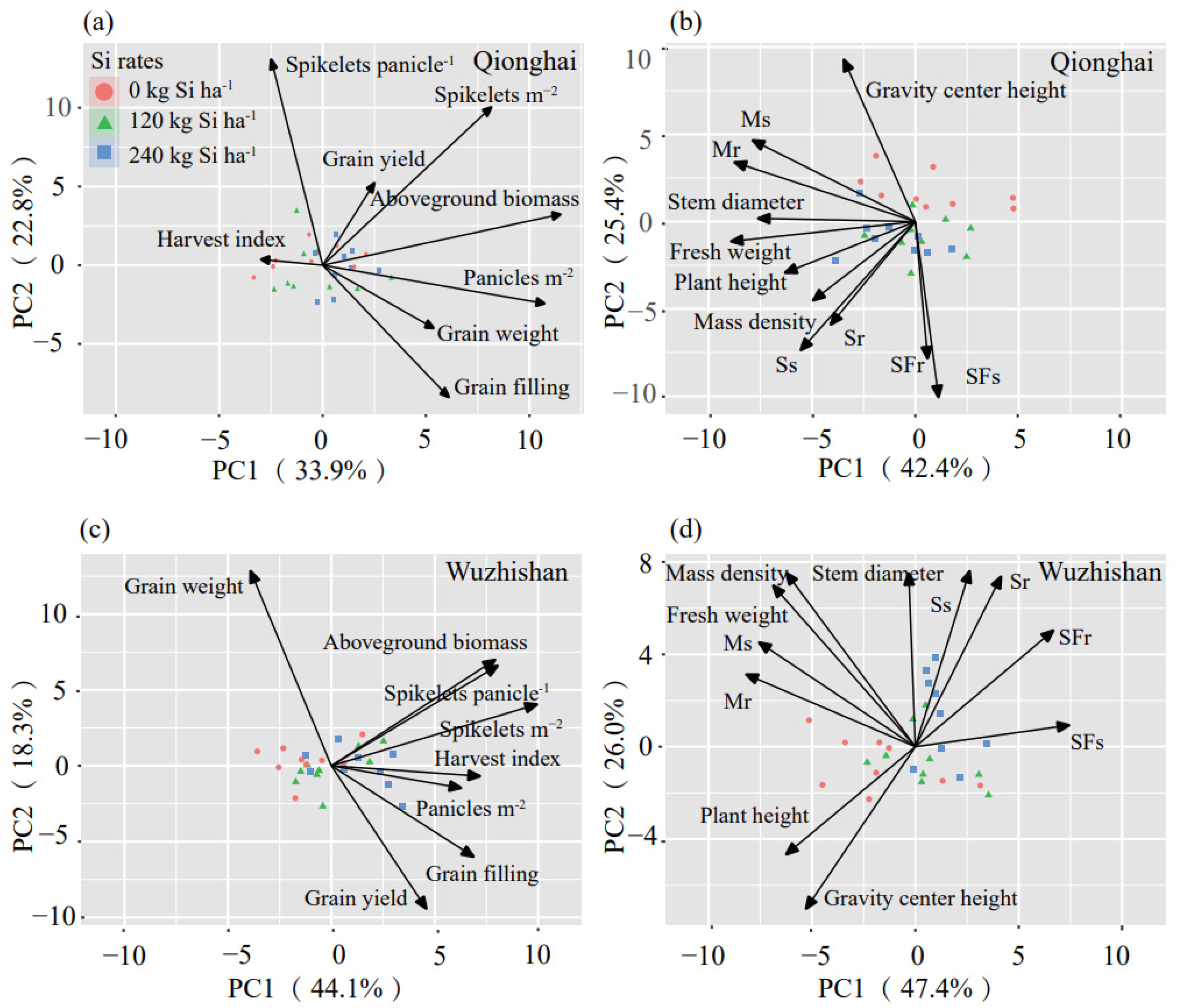
| Sites | Zn Rates | Si Rates | Panicles m−2 | Spikelets Panicle−1 | Spikelets m−2 | Grain Filling | Grain Weight | Grain Yield | Aboveground Biomass | Harvest Index |
|---|---|---|---|---|---|---|---|---|---|---|
| Qionghai | ||||||||||
| 0 | 0 | 344.5 b | 125.3 a | 4.32 a | 74.7 b | 26.3 b | 10.15 a | 17.6 b | 48.3 a | |
| 120 | 363.7 ab | 130.7 a | 4.67 a | 75.12 b | 27.40 a | 10.52 a | 18.68 ab | 51.11 a | ||
| 240 | 410.8 a | 112.1 a | 4.61 a | 84.85 a | 27.64 a | 10.41 a | 22.88 a | 47.43 a | ||
| Mean | 373.0 B | 122.7 A | 4.54 B | 78.23 A | 27.12 A | 10.36 B | 19.72 B | 48.96 A | ||
| 40 | 0 | 419.2 a | 125.1 a | 5.24 a | 74.98 c | 27.58 a | 11.04 a | 23.68 ab | 46.05 a | |
| 120 | 384.0 a | 121.0 a | 4.64 a | 77.08 b | 26.72 a | 11.72 a | 20.04 b | 47.91 a | ||
| 240 | 430.0 a | 120.0 a | 5.16 a | 82.20 a | 27.43 a | 11.13 a | 25.25 a | 46.05 a | ||
| Mean | 411.0 AB | 122.0 A | 5.01 A | 78.09 A | 27.25 A | 11.30 A | 22.99 A | 46.67 A | ||
| 80 | 0 | 417.1 a | 128.5 a | 5.31 a | 73.71 b | 27.16 a | 10.69 a | 23.29 a | 45.91 a | |
| 120 | 464.3 a | 110.2 b | 5.10 a | 86.48 a | 27.59 a | 10.92 a | 24.06 a | 50.53 a | ||
| 240 | 408.3 a | 135.6 a | 5.53 a | 77.88 b | 27.37 a | 11.02 a | 23.56 a | 50.23 a | ||
| Mean | 429.9 A | 124.8 A | 5.31 A | 79.35 A | 27.37 A | 10.88 AB | 23.64 A | 48.89 A | ||
| Wuzhishan | ||||||||||
| 0 | 0 | 204.9 b | 126.6 b | 2.59 b | 73.43 ab | 28.60 a | 8.01 b | 14.02 a | 43.97 b | |
| 120 | 227.0 a | 130.5 b | 2.96 a | 72.29 b | 28.29 a | 8.66 a | 12.95 a | 48.93 a | ||
| 240 | 200.6 b | 157.7 a | 3.16 a | 75.24 a | 28.57 a | 8.58 a | 15.02 a | 50.62 a | ||
| Mean | 210.8 B | 138.3 A | 2.91 B | 73.65 B | 28.48 A | 8.41 B | 14.00 B | 47.84 A | ||
| 40 | 0 | 233.2 a | 146.7 a | 3.42 a | 70.70 b | 28.39 a | 8.71 a | 15.44 a | 47.60 a | |
| 120 | 224.9 a | 151.6 a | 3.40 a | 75.75 a | 28.32 a | 8.79 a | 15.26 a | 46.82 a | ||
| 240 | 216.7 a | 153.9 a | 3.35 a | 76.63 a | 28.21 a | 9.03 a | 15.72 a | 47.50 a | ||
| Mean | 224.9 AB | 150.8 A | 3.39 A | 74.36 AB | 28.31 A | 8.85 A | 15.47 A | 47.31 A | ||
| 80 | 0 | 209.5 a | 137.7 a | 2.89 a | 72.11 c | 28.30 a | 8.83 a | 13.26 a | 49.00 b | |
| 120 | 237.2 a | 140.8 a | 3.35 a | 76.59 b | 28.18 a | 9.01 a | 15.14 a | 45.79 b | ||
| 240 | 237.3 a | 150.6 a | 3.57 a | 86.94 a | 27.53 a | 8.95 a | 15.58 a | 52.57 a | ||
| Mean | 228.0 A | 143.0 A | 3.27 AB | 78.55 A | 28.00 A | 8.93 A | 14.66 AB | 49.12 A | ||
| Site | Zn Rates | Si Rates | Gravity Center Height (cm) | Stem Diameter (mm) | Plant Height (cm) | Fresh Weight (g) | Mass Density (mg cm−1) |
|---|---|---|---|---|---|---|---|
| Qionghai | |||||||
| 0 | 0 | 48.43 a | 4.28 a | 91.04 a | 62.65 a | 4.08 a | |
| 120 | 48.23 a | 4.23 a | 94.23 a | 64.10 a | 4.38 a | ||
| 240 | 47.08 a | 4.68 a | 94.21 a | 75.80 a | 4.76 a | ||
| Mean | 47.92 B | 4.40 A | 93.16 B | 67.52 B | 4.41 A | ||
| 40 | 0 | 53.92 a | 4.09 a | 98.01 a | 71.39 b | 4.19 a | |
| 120 | 47.40 b | 4.55 a | 95.21 a | 78.11 ab | 4.48 a | ||
| 240 | 49.53 b | 4.76 a | 98.94 a | 84.33 a | 5.06 a | ||
| Mean | 50.28 AB | 4.47 A | 97.39 A | 77.94 A | 4.58 A | ||
| 80 | 0 | 55.52 a | 5.19 a | 97.53 a | 77.00 a | 3.92 a | |
| 120 | 48.83 b | 4.60 a | 101.43 a | 77.05 a | 4.61 a | ||
| 240 | 50.78 b | 4.58 a | 99.07 a | 77.06 a | 4.60 a | ||
| Mean | 51.71 A | 4.79 A | 99.34 A | 77.03 A | 4.38 A | ||
| Wuzhishan | |||||||
| 0 | 0 | 53.73 a | 4.30 a | 101.32 a | 119.74 a | 6.10 a | |
| 120 | 53.53 a | 4.10 a | 102.75 ab | 114.33 a | 5.52 ab | ||
| 240 | 53.00 a | 4.11 a | 98.48 b | 107.47 a | 5.03 b | ||
| Mean | 53.42 A | 4.17 A | 100.85 A | 113.85 A | 5.55 A | ||
| 40 | 0 | 53.93 a | 3.99 b | 100.41 a | 111.96 a | 5.26 a | |
| 120 | 52.53 ab | 3.82 b | 99.52 a | 109.26 a | 5.39 a | ||
| 240 | 50.53 b | 4.42 a | 97.33 a | 116.29 a | 5.89 a | ||
| Mean | 52.33 A | 4.08 A | 99.09 A | 112.51 A | 5.52 A | ||
| 80 | 0 | 54.40 a | 4.04 a | 101.10 a | 115.27 a | 5.56 a | |
| 120 | 52.53 a | 4.30 a | 98.60 ab | 106.89 a | 5.21 a | ||
| 240 | 51.53 a | 4.51 a | 95.23 b | 114.98 a | 5.67 a | ||
| Mean | 52.82 A | 4.28 A | 98.31 A | 112.38 A | 5.48 A | ||
Disclaimer/Publisher’s Note: The statements, opinions and data contained in all publications are solely those of the individual author(s) and contributor(s) and not of MDPI and/or the editor(s). MDPI and/or the editor(s) disclaim responsibility for any injury to people or property resulting from any ideas, methods, instructions or products referred to in the content. |
© 2023 by the authors. Licensee MDPI, Basel, Switzerland. This article is an open access article distributed under the terms and conditions of the Creative Commons Attribution (CC BY) license (https://creativecommons.org/licenses/by/4.0/).
Share and Cite
Fu, W.; Zhao, Y.; Zha, X.; Ullah, J.; Ye, M.; Shah, F.; Yuan, Q.; Wang, P.; Tao, Y.; Wu, W. The Potential Role of Zinc and Silicon in Improving Grain Yield and Lodging Resistance of Rice (Oryza sativa L.). Agronomy 2024, 14, 91. https://doi.org/10.3390/agronomy14010091
Fu W, Zhao Y, Zha X, Ullah J, Ye M, Shah F, Yuan Q, Wang P, Tao Y, Wu W. The Potential Role of Zinc and Silicon in Improving Grain Yield and Lodging Resistance of Rice (Oryza sativa L.). Agronomy. 2024; 14(1):91. https://doi.org/10.3390/agronomy14010091
Chicago/Turabian StyleFu, Weiqing, Yanjie Zhao, Xinrui Zha, Jawad Ullah, Mao Ye, Farooq Shah, Qianhua Yuan, Peng Wang, Yang Tao, and Wei Wu. 2024. "The Potential Role of Zinc and Silicon in Improving Grain Yield and Lodging Resistance of Rice (Oryza sativa L.)" Agronomy 14, no. 1: 91. https://doi.org/10.3390/agronomy14010091





